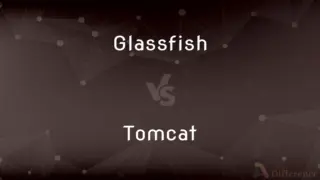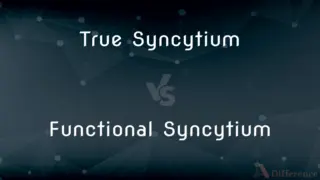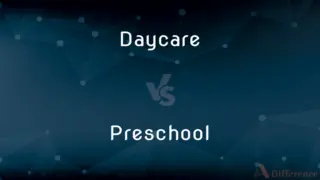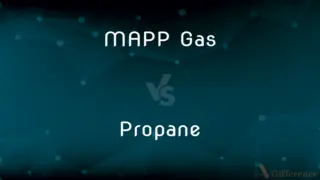Grazing vs. Detritus — What's the Difference?
By Maham Liaqat & Fiza Rafique — Published on December 2, 2024
Grazing involves animals feeding on living plant material, impacting ecosystem structure, while detritus refers to dead organic matter, crucial for nutrient recycling and supporting detritivores.

Difference Between Grazing and Detritus
Table of Contents
ADVERTISEMENT
Key Differences
Grazing is a biological interaction where herbivores feed on plants, directly influencing plant community composition and growth. Detritus, on the other hand, consists of decomposed plant and animal matter, forming the base of a critical ecosystem process that recycles nutrients back into the soil.
Grazers can affect the spatial distribution and abundance of plant species through selective feeding, potentially leading to changes in habitat structure. Detritus provides a food source for a wide range of organisms, including bacteria, fungi, and detritivores, which break down the matter and contribute to the decomposition process.
The impact of grazing on ecosystems can be both positive and negative, promoting biodiversity in moderate levels by preventing any single species from dominating, whereas excessive grazing can lead to degradation and loss of vegetation. Detritus plays a predominantly positive role by enriching the soil and supporting the base of many food webs, especially in aquatic ecosystems.
Grazing dynamics are influenced by the type of grazers, their population density, and the plant species available. The composition and amount of detritus in an ecosystem depend on factors such as the types of organisms that have died, environmental conditions, and the presence of decomposers.
Management practices in ecosystems often aim to balance grazing pressures to maintain healthy plant communities, whereas detritus management focuses on ensuring efficient decomposition and nutrient cycling, often through conservation of detritivore populations and habitat.
ADVERTISEMENT
Comparison Chart
Definition
The act of animals feeding on live plant material.
Dead organic matter from decomposed plants and animals.
Primary Function
Directly influences plant growth and ecosystem structure.
Provides nutrients for soil and food for detritivores.
Ecosystem Impact
Can alter plant diversity and habitat structure.
Essential for nutrient recycling and supporting food webs.
Influencing Factors
Type and density of grazing animals, plant availability.
Types of organic matter, environmental conditions, decomposer activity.
Management Concerns
Balancing grazing to prevent overgrazing and vegetation loss.
Ensuring efficient decomposition and nutrient cycling.
Compare with Definitions
Grazing
The consumption of plant material by herbivores.
Cattle grazing in a field contribute to the shaping of the landscape.
Detritus
Decomposed organic matter from dead plants and animals.
Leaf litter on the forest floor forms a layer of detritus that nourishes the soil.
Grazing
Can lead to overgrazing if not managed.
Overgrazing by sheep has led to significant soil erosion in some areas.
Detritus
Serves as a food source for detritivores.
Earthworms feed on detritus, aiding in decomposition.
Grazing
Influences plant community dynamics.
Selective grazing by deer can lead to an increase in plant species diversity.
Detritus
Supports diverse microbial communities.
Microbes thriving in detritus break down complex organic molecules.
Grazing
Plays a role in nutrient cycling through fecal deposits.
Grazer feces enrich the soil, promoting new plant growth.
Detritus
Crucial for nutrient recycling in ecosystems.
Detritus decomposition releases essential nutrients back into the ecosystem.
Grazing
Affects the spatial distribution of plants.
Grazing pressure can create patches of different plant communities within an ecosystem.
Detritus
Influences soil health and fertility.
The accumulation of detritus improves soil structure and water retention.
Grazing
To feed on growing grasses and herbage.
Detritus
Loose fragments or grains that have been worn away from rock.
Grazing
To afford herbage for the feeding of
This field will graze 30 head of cattle.
Detritus
Pieces of rock broken off by ice, glacier, or erosion.
Grazing
The action of animals eating, mainly of grass in a field or on other grassland.
Detritus
Organic waste material from decomposing dead plants or animals.
Grazing
A pasture; growing grass.
Detritus
A mass of substances worn off from solid bodies by attrition, and reduced to small portions; as, diluvial detritus.
Detritus
The remains of something that has been destroyed or broken up
Detritus
Loose material (stone fragments and silt etc) that is worn away from rocks
Common Curiosities
What role do detritivores play in the detritus food web?
Detritivores, like earthworms and certain insects, feed on detritus, breaking it down further and facilitating nutrient recycling.
How is detritus formed?
Detritus is formed through the decomposition of dead organic matter, including plants, animals, and other organisms, by bacteria, fungi, and other decomposers.
Can grazing lead to negative environmental impacts?
Yes, overgrazing can cause soil erosion, loss of plant species, and habitat degradation.
How does grazing affect plant diversity?
Moderate grazing can increase plant diversity by preventing dominance of certain species, but excessive grazing can reduce diversity and lead to vegetation loss.
Are there ecosystems that depend on detritus?
Yes, many aquatic ecosystems, such as wetlands and deep-sea floors, heavily rely on detritus as a primary energy source.
Is all grazing detrimental to ecosystems?
No, when managed properly, grazing can be beneficial by maintaining grassland health and encouraging biodiversity.
How do ecosystems recover from overgrazing?
Recovery can involve rest periods from grazing, reseeding of native plants, and sometimes, intervention to reduce grazer populations.
Can grazing be used as a land management tool?
Yes, controlled grazing is used in some areas to manage vegetation and reduce wildfire risk.
How do different types of grazers affect ecosystems?
Different grazers, like browsers, grazers, and mixed-feeders, have varied impacts on vegetation structure and species composition.
What management strategies are used to prevent overgrazing?
Strategies include rotational grazing, setting stocking rates, and protecting sensitive areas.
What factors influence the rate of detritus decomposition?
Factors include the type of detritus, temperature, moisture, and the presence and activity of decomposers.
How does detritus contribute to soil fertility?
As detritus decomposes, it releases nutrients into the soil, improving its fertility and structure.
What happens if detritivores are removed from an ecosystem?
The decomposition of organic matter would slow down, leading to nutrient accumulation in detritus form and potentially harming the ecosystem's health.
Why is detritus important in aquatic ecosystems?
In aquatic systems, detritus serves as a primary food source for many organisms, supporting diverse food webs.
How can overgrazing impact water cycles?
Overgrazing can compact soil, reduce infiltration, and increase runoff, negatively affecting water availability and quality.
Share Your Discovery

Previous Comparison
Glassfish vs. Tomcat
Next Comparison
True Syncytium vs. Functional SyncytiumAuthor Spotlight
Written by
Maham LiaqatCo-written by
Fiza RafiqueFiza Rafique is a skilled content writer at AskDifference.com, where she meticulously refines and enhances written pieces. Drawing from her vast editorial expertise, Fiza ensures clarity, accuracy, and precision in every article. Passionate about language, she continually seeks to elevate the quality of content for readers worldwide.















































